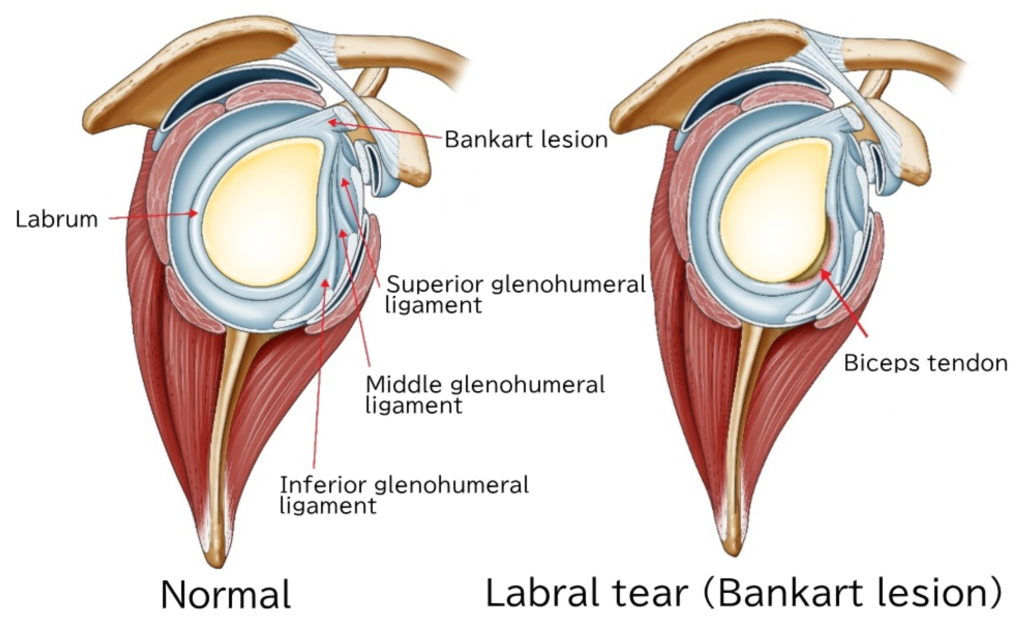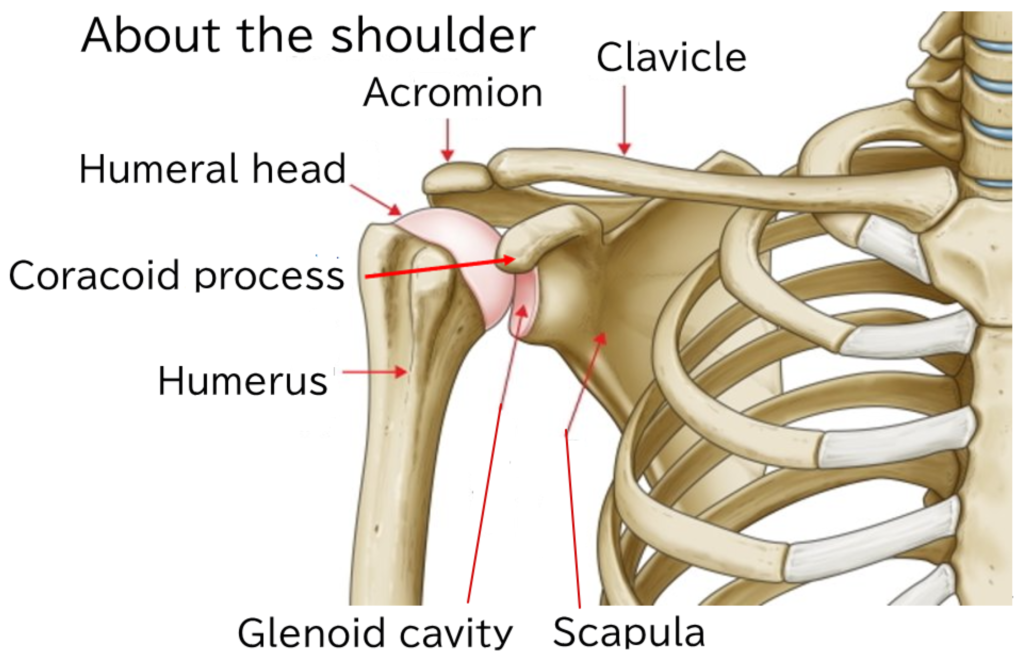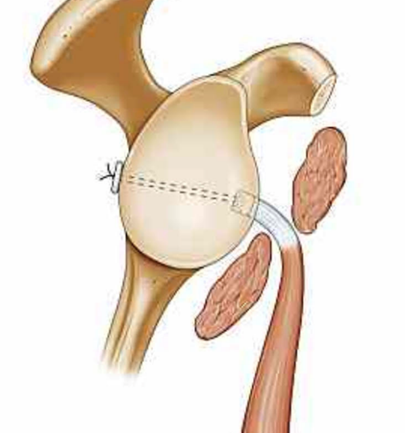There are two globally effective surgeries, and our clinic is equipped to perform both.
①Arthroscopic Bankart repair
Arthroscopic Bankart repair is a surgical procedure to treat shoulder instability and recurrent dislocations by repairing the damaged labrum (part of the shoulder cartilage). It is performed with minimal incisions using an arthroscope, making it a minimally invasive procedure with a faster recovery time.
What is a Bankart lesion?
A Bankart lesion refers to the tearing or detachment of the anterior labrum of the shoulder due to anterior shoulder dislocation. The shoulder joint has a wide range of motion but relatively weak stability, making it prone to dislocation from sports or trauma.
・The labrum is a ring of cartilage that surrounds the glenoid (the socket of the shoulder) and helps stabilize the shoulder bone (humeral head).
・When dislocated, the labrum can be torn or detached from the bone, leading to shoulder instability and recurrent dislocations. If a Bankart lesion is not repaired, the shoulder is more likely to dislocate repeatedly.

Characteristics of Arthroscopic Bankart Repair
Arthroscopic Bankart repair is a surgical procedure to restore the damaged labrum to its original position and regain shoulder stability. It is characterized by minimal incisions due to the use of an arthroscope, reducing the burden on the patient.
Indications for surgery
Arthroscopic Bankart repair is indicated in the following cases:
・Recurrent dislocations: When the shoulder dislocates repeatedly.
・Shoulder instability: When the shoulder is unstable, causing problems in daily activities or sports.
・Dislocation due to trauma: When the shoulder is dislocated from sports or accidents, resulting in a damaged labrum.
Surgical procedure
[Anesthesia]
・The surgery is usually performed under general or local anesthesia.
[Insertion and observation with an arthroscope]
・A small incision of a few millimeters is made in the shoulder, and an arthroscope is inserted. The interior of the shoulder is observed through the camera to assess the extent of the damage. The location of the detached or torn labrum is confirmed on the monitor.
[Repair of damaged parts]
・The detached labrum is returned to the bone (glenoid) using anchors (small fixatives) or sutures. Anchors are inserted into the glenoid and the labrum is pulled back and fixed in its original position, thus stabilizing the shoulder joint.
[Confirmation and completion]
・After confirming the repair inside the joint, the arthroscope is removed and the incision is closed. The surgery typically takes 1 to 2 hours.

Postoperative rehabilitation
Postoperative rehabilitation is important to restore shoulder function and prevent further dislocations. Rehabilitation is conducted in stages:
Immobilization period (1-4 weeks postoperative):
・The shoulder is kept at rest using a sling or brace to immobilize it. During this period, the shoulder is kept still to promote tissue healing.
Range of motion recovery (4-8 weeks postoperative):
・Under the guidance of a rehabilitation specialist, stretches and light exercises are performed to gradually expand the range of motion in the shoulder. The shoulder is moved fully but within a tolerable range.
Strength training (8-12 weeks postoperative):
・Training is conducted to strengthen the muscles around the shoulder, improving shoulder joint stability. Gradual return to daily activities becomes possible.
Return to sports (3-6 months postoperative):
・Approximately 3 to 6 months postoperative, return to sports and strenuous activities becomes possible. In cases of contact sports, full shoulder recovery is necessary before returning.
Risks and complications of surgery
Arthroscopic Bankart repair is a relatively safe procedure, but there are potential risks and complications, including:
・Infections
・Re-tearing or re-dislocation at the suture site
・Blood clots
・Limited range of motion or stiffness in the shoulder
・Nerve damage
Conclusion
Arthroscopic Bankart repair is an effective surgical procedure to treat shoulder instability and recurrent dislocations. The use of an arthroscope minimizes invasiveness and allows for a faster recovery. Postoperative rehabilitation is crucial and should be carried out carefully to fully restore shoulder function.
②Coracoid transfer surgery
Coracoid transfer surgery is a procedure to treat shoulder instability. It is particularly effective for individuals who frequently experience shoulder dislocations. First, let's briefly explain the content of the surgery using illustrations.
Surgical procedure

Figure 1: Comparison of a healthy shoulder and an unstable shoulder [Healthy shoulder and unstable shoulder]

Figure 2: Position of the coracoid process
[Position of the coracoid process]
1. As shown in the figure, the coracoid process is part of the scapula, and moving it enhances shoulder stability.
2. The surgery is performed using an arthroscope, a small camera, to minimize incisions. This promotes faster recovery.
3. The coracoid process is moved from its original position to a more stable location and fixed in place.

Below are the advantages and disadvantages of this surgery.
[Advantages]
・ Improved shoulder stability: This procedure offers better shoulder joint stability compared to arthroscopic Bankart repair, reducing the risk of dislocation.
・ Faster return to sports and daily activities: With proper rehabilitation, patients can quickly resume sports and everyday activities.
・ Minimally invasive: Using an arthroscope results in smaller incisions and quicker recovery.
[Disadvantages]
・There are surgical risks, including the potential for infections, nerve damage, and blood clots.
・After surgery, shoulder movement may be temporarily restricted.
・There is a risk that the sutured area may tear again or dislocate.
Coracoid process transfer surgery is a procedure to treat shoulder instability. Here are the advantages and disadvantages of this surgery.
This surgery is especially effective for individuals who frequently dislocate their shoulders or engage in sports. By undergoing this procedure, patients can restore shoulder function and safely enjoy daily activities and sports once again.
Outpatient Reception & Consultation Hours
| Business Hours | 月 | 火 | 水 | 木 | 金 | 土 | 日 |
|---|---|---|---|---|---|---|---|
| 13:00~17:00 | ● | ● | ー | ● | ● | ー | ● |
| 18:00~20:00 | ● | ● | ー | ● | ● | ー | ● |
【Closed Days】 Wednesday, Saturday, and Public Holidays.
※translates to "Reception ends 30 minutes before the end of consultation hours."
